(Solved) 3D Printing Case Study
VerifiedAdded on 2021/06/15
|14
|3580
|478
AI Summary
Contribute Materials
Your contribution can guide someone’s learning journey. Share your
documents today.
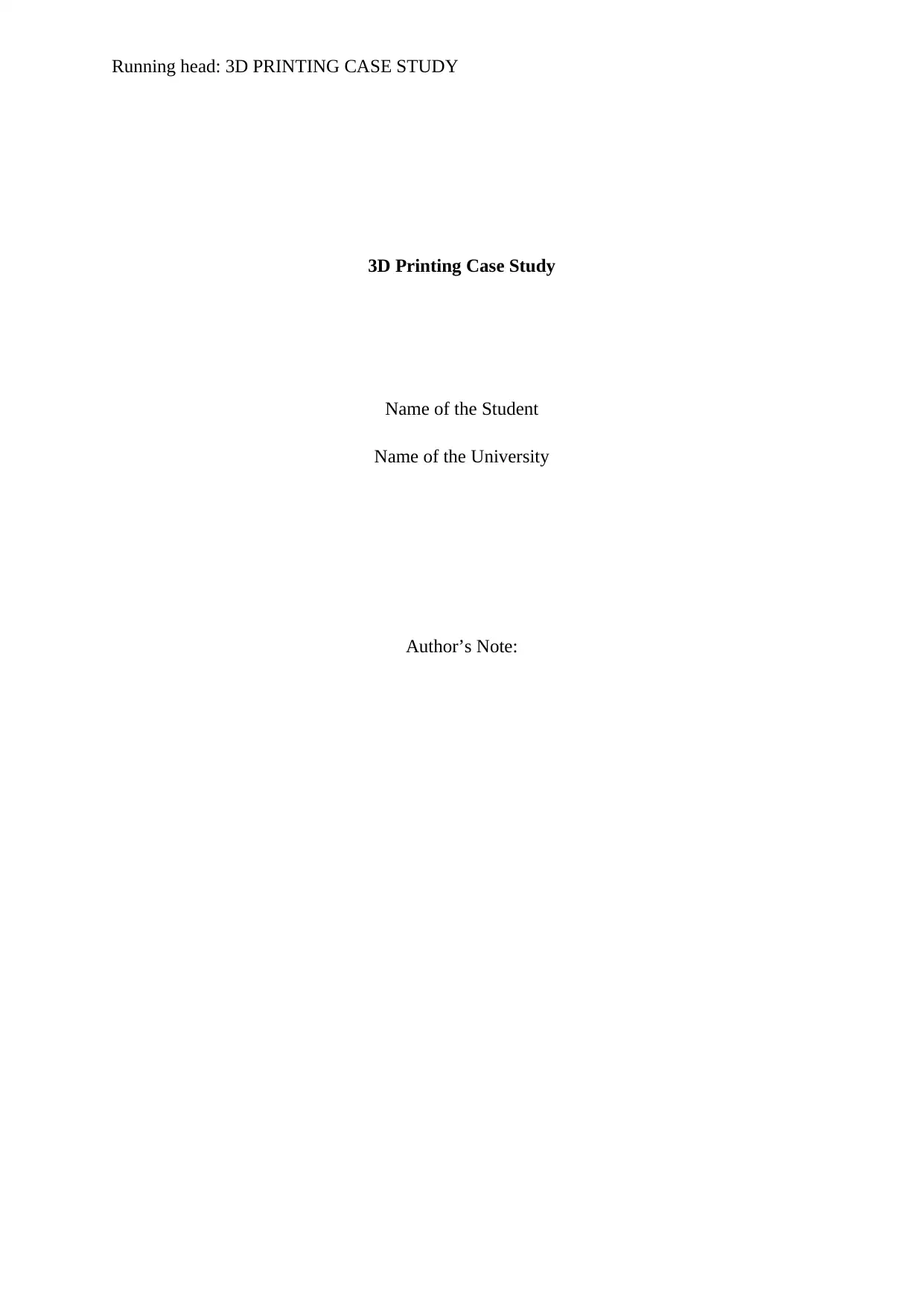
Running head: 3D PRINTING CASE STUDY
3D Printing Case Study
Name of the Student
Name of the University
Author’s Note:
3D Printing Case Study
Name of the Student
Name of the University
Author’s Note:
Secure Best Marks with AI Grader
Need help grading? Try our AI Grader for instant feedback on your assignments.
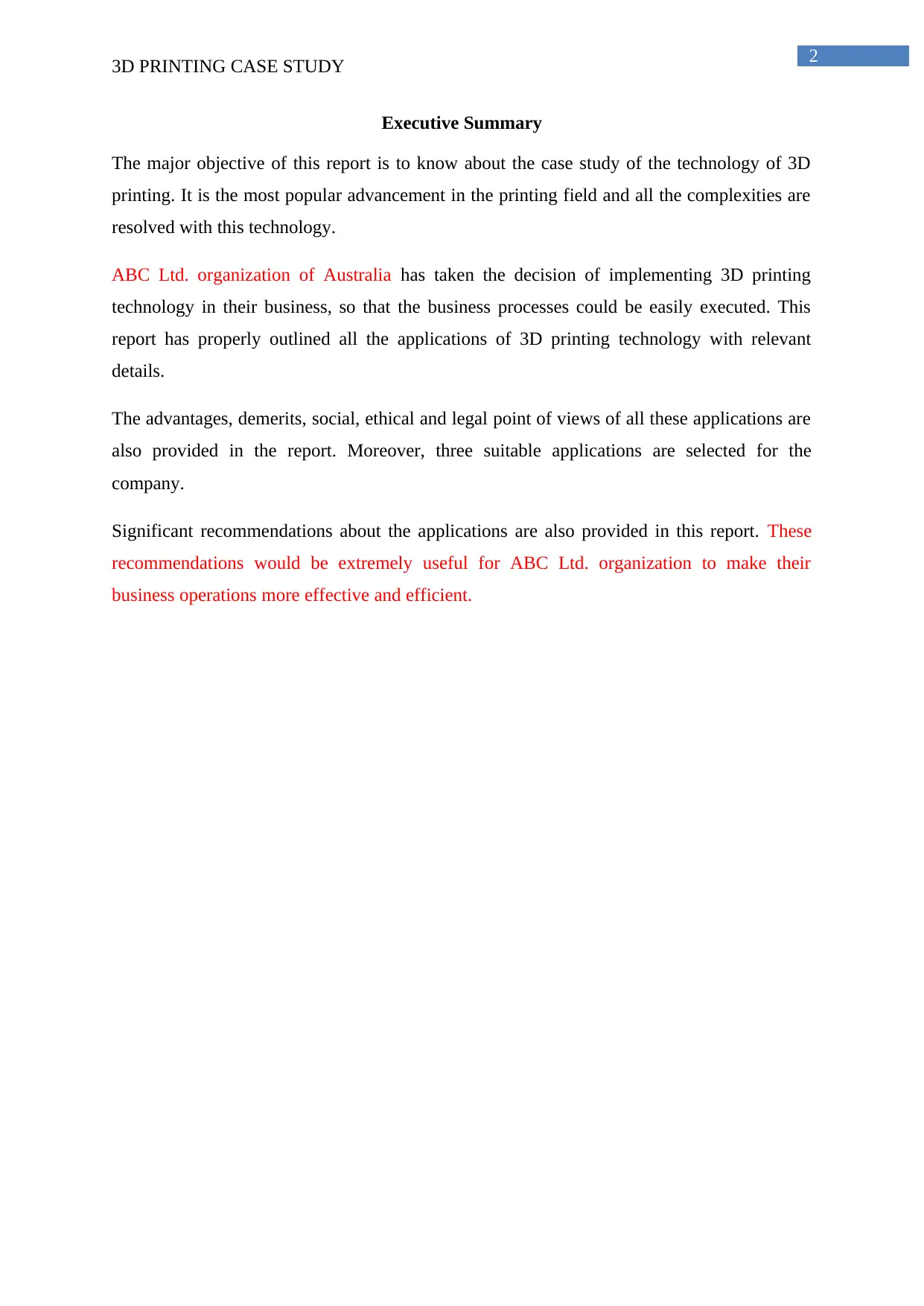
2
3D PRINTING CASE STUDY
Executive Summary
The major objective of this report is to know about the case study of the technology of 3D
printing. It is the most popular advancement in the printing field and all the complexities are
resolved with this technology.
ABC Ltd. organization of Australia has taken the decision of implementing 3D printing
technology in their business, so that the business processes could be easily executed. This
report has properly outlined all the applications of 3D printing technology with relevant
details.
The advantages, demerits, social, ethical and legal point of views of all these applications are
also provided in the report. Moreover, three suitable applications are selected for the
company.
Significant recommendations about the applications are also provided in this report. These
recommendations would be extremely useful for ABC Ltd. organization to make their
business operations more effective and efficient.
3D PRINTING CASE STUDY
Executive Summary
The major objective of this report is to know about the case study of the technology of 3D
printing. It is the most popular advancement in the printing field and all the complexities are
resolved with this technology.
ABC Ltd. organization of Australia has taken the decision of implementing 3D printing
technology in their business, so that the business processes could be easily executed. This
report has properly outlined all the applications of 3D printing technology with relevant
details.
The advantages, demerits, social, ethical and legal point of views of all these applications are
also provided in the report. Moreover, three suitable applications are selected for the
company.
Significant recommendations about the applications are also provided in this report. These
recommendations would be extremely useful for ABC Ltd. organization to make their
business operations more effective and efficient.
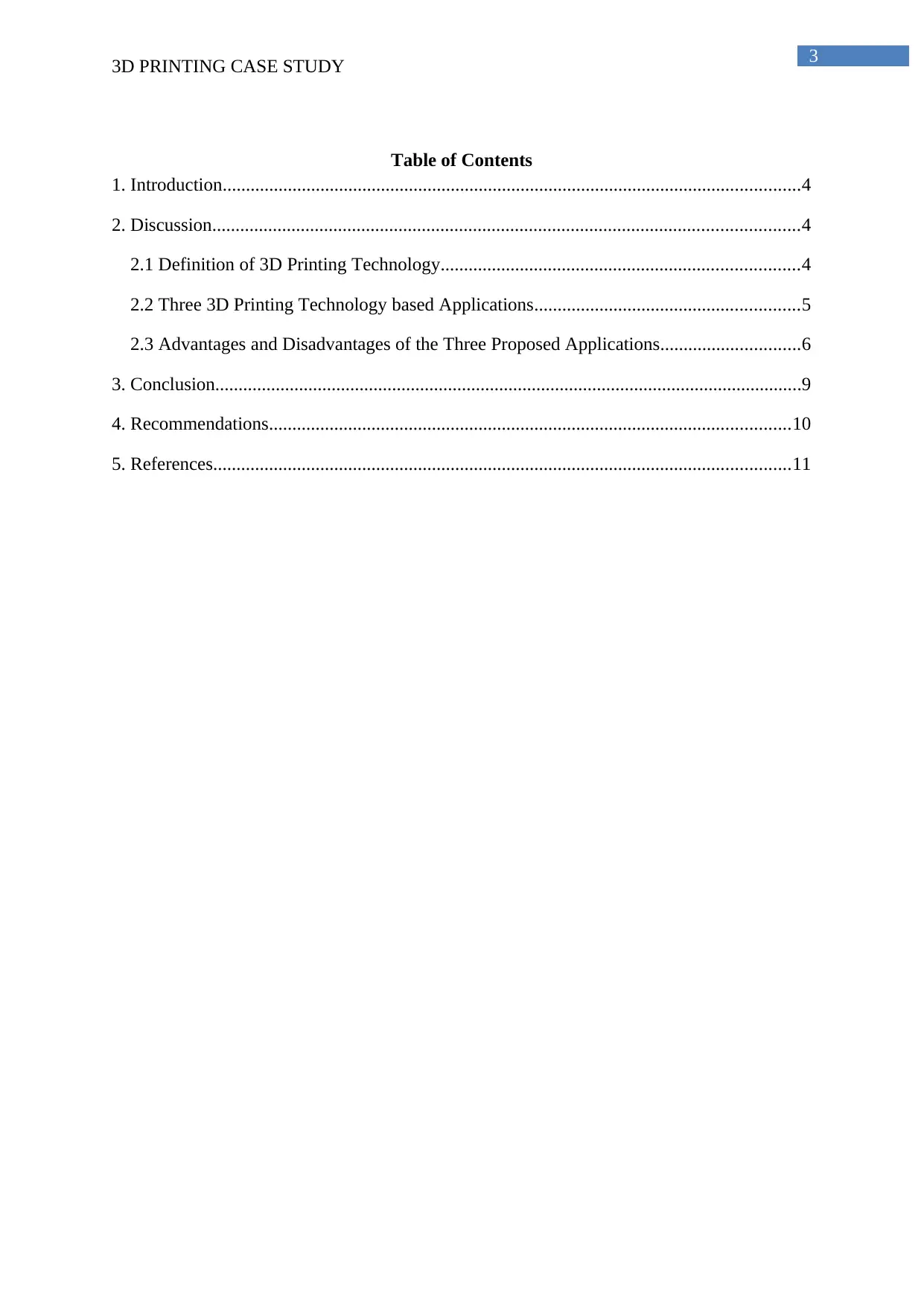
3
3D PRINTING CASE STUDY
Table of Contents
1. Introduction............................................................................................................................4
2. Discussion..............................................................................................................................4
2.1 Definition of 3D Printing Technology.............................................................................4
2.2 Three 3D Printing Technology based Applications.........................................................5
2.3 Advantages and Disadvantages of the Three Proposed Applications..............................6
3. Conclusion..............................................................................................................................9
4. Recommendations................................................................................................................10
5. References............................................................................................................................11
3D PRINTING CASE STUDY
Table of Contents
1. Introduction............................................................................................................................4
2. Discussion..............................................................................................................................4
2.1 Definition of 3D Printing Technology.............................................................................4
2.2 Three 3D Printing Technology based Applications.........................................................5
2.3 Advantages and Disadvantages of the Three Proposed Applications..............................6
3. Conclusion..............................................................................................................................9
4. Recommendations................................................................................................................10
5. References............................................................................................................................11
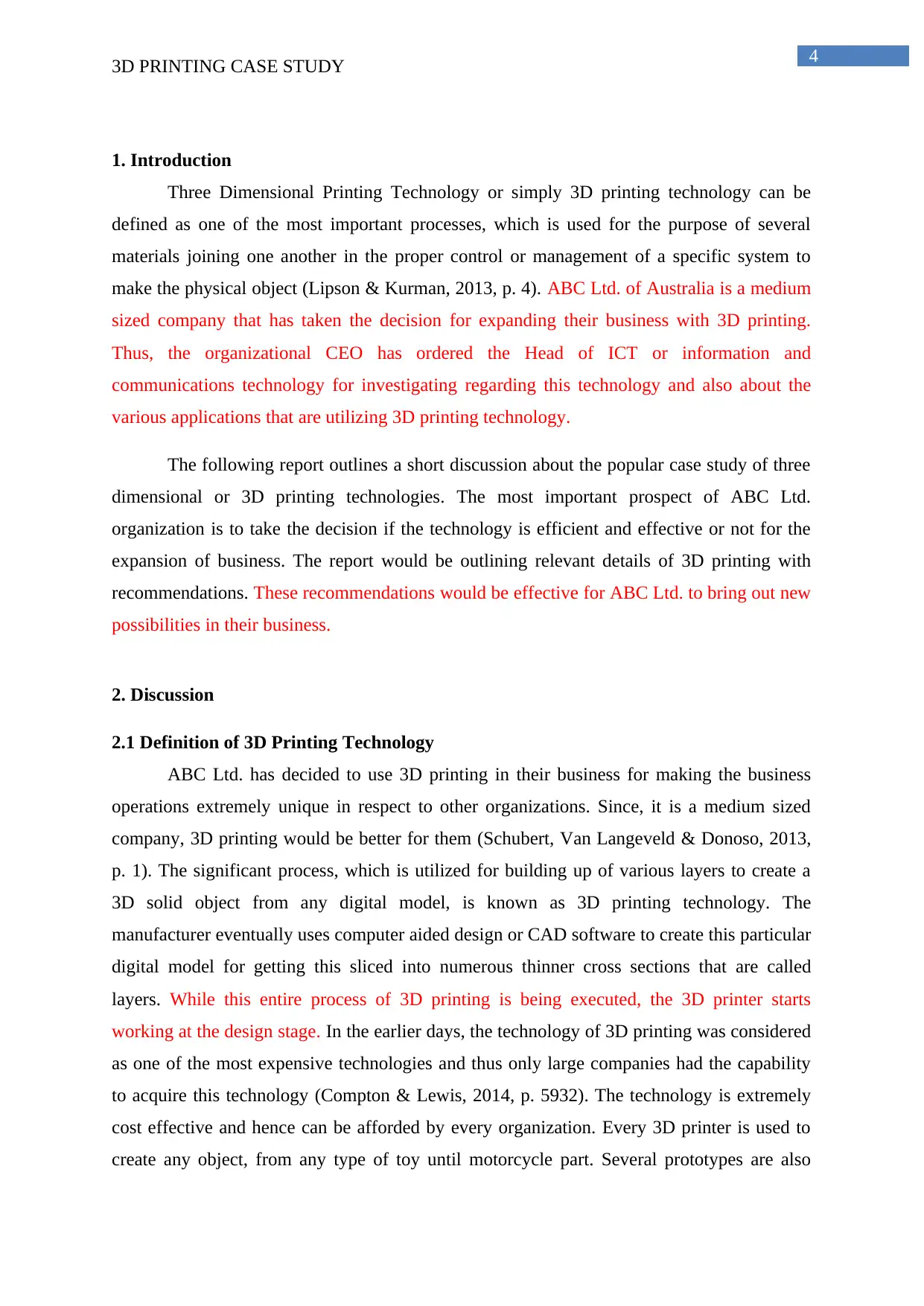
4
3D PRINTING CASE STUDY
1. Introduction
Three Dimensional Printing Technology or simply 3D printing technology can be
defined as one of the most important processes, which is used for the purpose of several
materials joining one another in the proper control or management of a specific system to
make the physical object (Lipson & Kurman, 2013, p. 4). ABC Ltd. of Australia is a medium
sized company that has taken the decision for expanding their business with 3D printing.
Thus, the organizational CEO has ordered the Head of ICT or information and
communications technology for investigating regarding this technology and also about the
various applications that are utilizing 3D printing technology.
The following report outlines a short discussion about the popular case study of three
dimensional or 3D printing technologies. The most important prospect of ABC Ltd.
organization is to take the decision if the technology is efficient and effective or not for the
expansion of business. The report would be outlining relevant details of 3D printing with
recommendations. These recommendations would be effective for ABC Ltd. to bring out new
possibilities in their business.
2. Discussion
2.1 Definition of 3D Printing Technology
ABC Ltd. has decided to use 3D printing in their business for making the business
operations extremely unique in respect to other organizations. Since, it is a medium sized
company, 3D printing would be better for them (Schubert, Van Langeveld & Donoso, 2013,
p. 1). The significant process, which is utilized for building up of various layers to create a
3D solid object from any digital model, is known as 3D printing technology. The
manufacturer eventually uses computer aided design or CAD software to create this particular
digital model for getting this sliced into numerous thinner cross sections that are called
layers. While this entire process of 3D printing is being executed, the 3D printer starts
working at the design stage. In the earlier days, the technology of 3D printing was considered
as one of the most expensive technologies and thus only large companies had the capability
to acquire this technology (Compton & Lewis, 2014, p. 5932). The technology is extremely
cost effective and hence can be afforded by every organization. Every 3D printer is used to
create any object, from any type of toy until motorcycle part. Several prototypes are also
3D PRINTING CASE STUDY
1. Introduction
Three Dimensional Printing Technology or simply 3D printing technology can be
defined as one of the most important processes, which is used for the purpose of several
materials joining one another in the proper control or management of a specific system to
make the physical object (Lipson & Kurman, 2013, p. 4). ABC Ltd. of Australia is a medium
sized company that has taken the decision for expanding their business with 3D printing.
Thus, the organizational CEO has ordered the Head of ICT or information and
communications technology for investigating regarding this technology and also about the
various applications that are utilizing 3D printing technology.
The following report outlines a short discussion about the popular case study of three
dimensional or 3D printing technologies. The most important prospect of ABC Ltd.
organization is to take the decision if the technology is efficient and effective or not for the
expansion of business. The report would be outlining relevant details of 3D printing with
recommendations. These recommendations would be effective for ABC Ltd. to bring out new
possibilities in their business.
2. Discussion
2.1 Definition of 3D Printing Technology
ABC Ltd. has decided to use 3D printing in their business for making the business
operations extremely unique in respect to other organizations. Since, it is a medium sized
company, 3D printing would be better for them (Schubert, Van Langeveld & Donoso, 2013,
p. 1). The significant process, which is utilized for building up of various layers to create a
3D solid object from any digital model, is known as 3D printing technology. The
manufacturer eventually uses computer aided design or CAD software to create this particular
digital model for getting this sliced into numerous thinner cross sections that are called
layers. While this entire process of 3D printing is being executed, the 3D printer starts
working at the design stage. In the earlier days, the technology of 3D printing was considered
as one of the most expensive technologies and thus only large companies had the capability
to acquire this technology (Compton & Lewis, 2014, p. 5932). The technology is extremely
cost effective and hence can be afforded by every organization. Every 3D printer is used to
create any object, from any type of toy until motorcycle part. Several prototypes are also
Secure Best Marks with AI Grader
Need help grading? Try our AI Grader for instant feedback on your assignments.
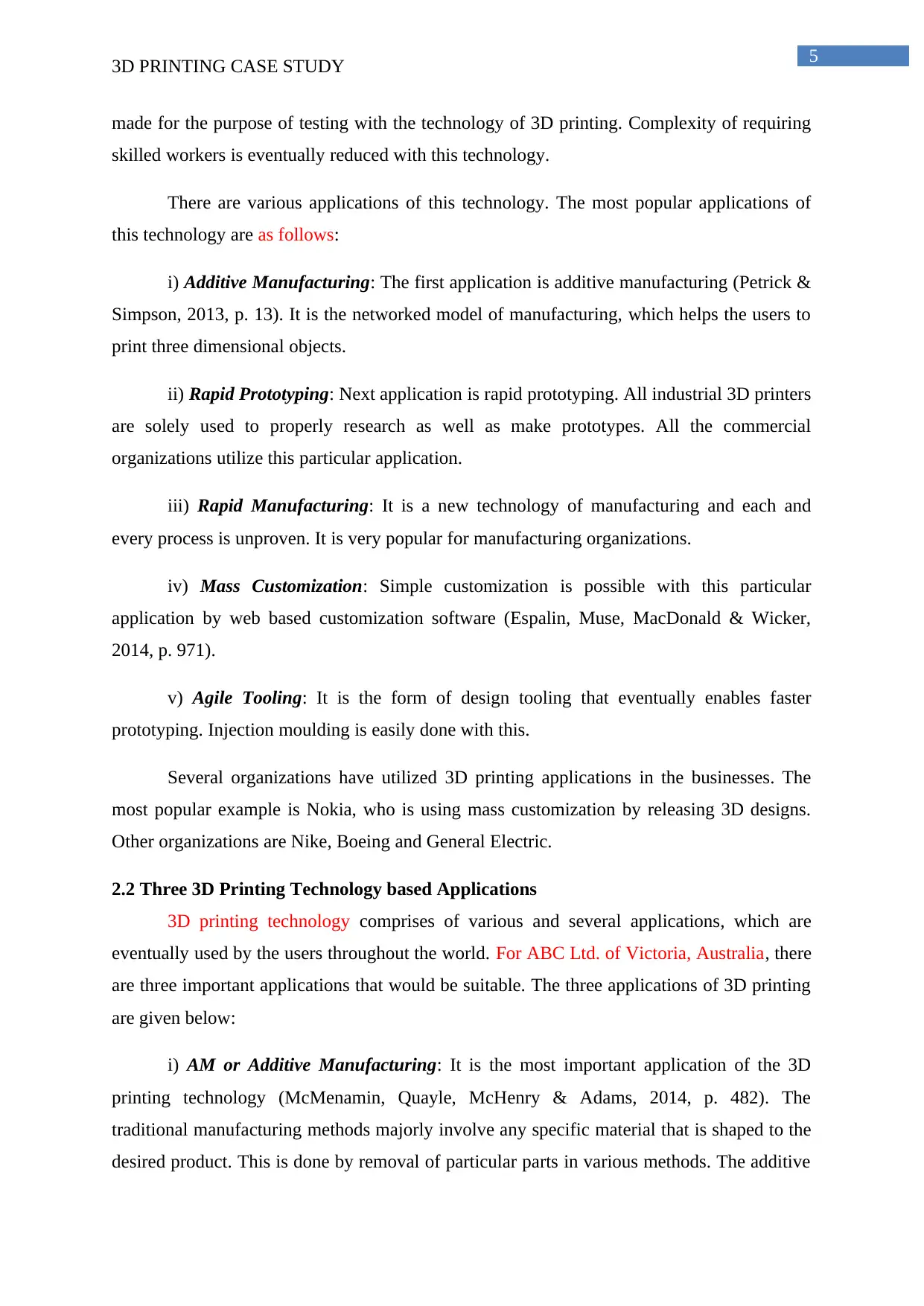
5
3D PRINTING CASE STUDY
made for the purpose of testing with the technology of 3D printing. Complexity of requiring
skilled workers is eventually reduced with this technology.
There are various applications of this technology. The most popular applications of
this technology are as follows:
i) Additive Manufacturing: The first application is additive manufacturing (Petrick &
Simpson, 2013, p. 13). It is the networked model of manufacturing, which helps the users to
print three dimensional objects.
ii) Rapid Prototyping: Next application is rapid prototyping. All industrial 3D printers
are solely used to properly research as well as make prototypes. All the commercial
organizations utilize this particular application.
iii) Rapid Manufacturing: It is a new technology of manufacturing and each and
every process is unproven. It is very popular for manufacturing organizations.
iv) Mass Customization: Simple customization is possible with this particular
application by web based customization software (Espalin, Muse, MacDonald & Wicker,
2014, p. 971).
v) Agile Tooling: It is the form of design tooling that eventually enables faster
prototyping. Injection moulding is easily done with this.
Several organizations have utilized 3D printing applications in the businesses. The
most popular example is Nokia, who is using mass customization by releasing 3D designs.
Other organizations are Nike, Boeing and General Electric.
2.2 Three 3D Printing Technology based Applications
3D printing technology comprises of various and several applications, which are
eventually used by the users throughout the world. For ABC Ltd. of Victoria, Australia, there
are three important applications that would be suitable. The three applications of 3D printing
are given below:
i) AM or Additive Manufacturing: It is the most important application of the 3D
printing technology (McMenamin, Quayle, McHenry & Adams, 2014, p. 482). The
traditional manufacturing methods majorly involve any specific material that is shaped to the
desired product. This is done by removal of particular parts in various methods. The additive
3D PRINTING CASE STUDY
made for the purpose of testing with the technology of 3D printing. Complexity of requiring
skilled workers is eventually reduced with this technology.
There are various applications of this technology. The most popular applications of
this technology are as follows:
i) Additive Manufacturing: The first application is additive manufacturing (Petrick &
Simpson, 2013, p. 13). It is the networked model of manufacturing, which helps the users to
print three dimensional objects.
ii) Rapid Prototyping: Next application is rapid prototyping. All industrial 3D printers
are solely used to properly research as well as make prototypes. All the commercial
organizations utilize this particular application.
iii) Rapid Manufacturing: It is a new technology of manufacturing and each and
every process is unproven. It is very popular for manufacturing organizations.
iv) Mass Customization: Simple customization is possible with this particular
application by web based customization software (Espalin, Muse, MacDonald & Wicker,
2014, p. 971).
v) Agile Tooling: It is the form of design tooling that eventually enables faster
prototyping. Injection moulding is easily done with this.
Several organizations have utilized 3D printing applications in the businesses. The
most popular example is Nokia, who is using mass customization by releasing 3D designs.
Other organizations are Nike, Boeing and General Electric.
2.2 Three 3D Printing Technology based Applications
3D printing technology comprises of various and several applications, which are
eventually used by the users throughout the world. For ABC Ltd. of Victoria, Australia, there
are three important applications that would be suitable. The three applications of 3D printing
are given below:
i) AM or Additive Manufacturing: It is the most important application of the 3D
printing technology (McMenamin, Quayle, McHenry & Adams, 2014, p. 482). The
traditional manufacturing methods majorly involve any specific material that is shaped to the
desired product. This is done by removal of particular parts in various methods. The additive
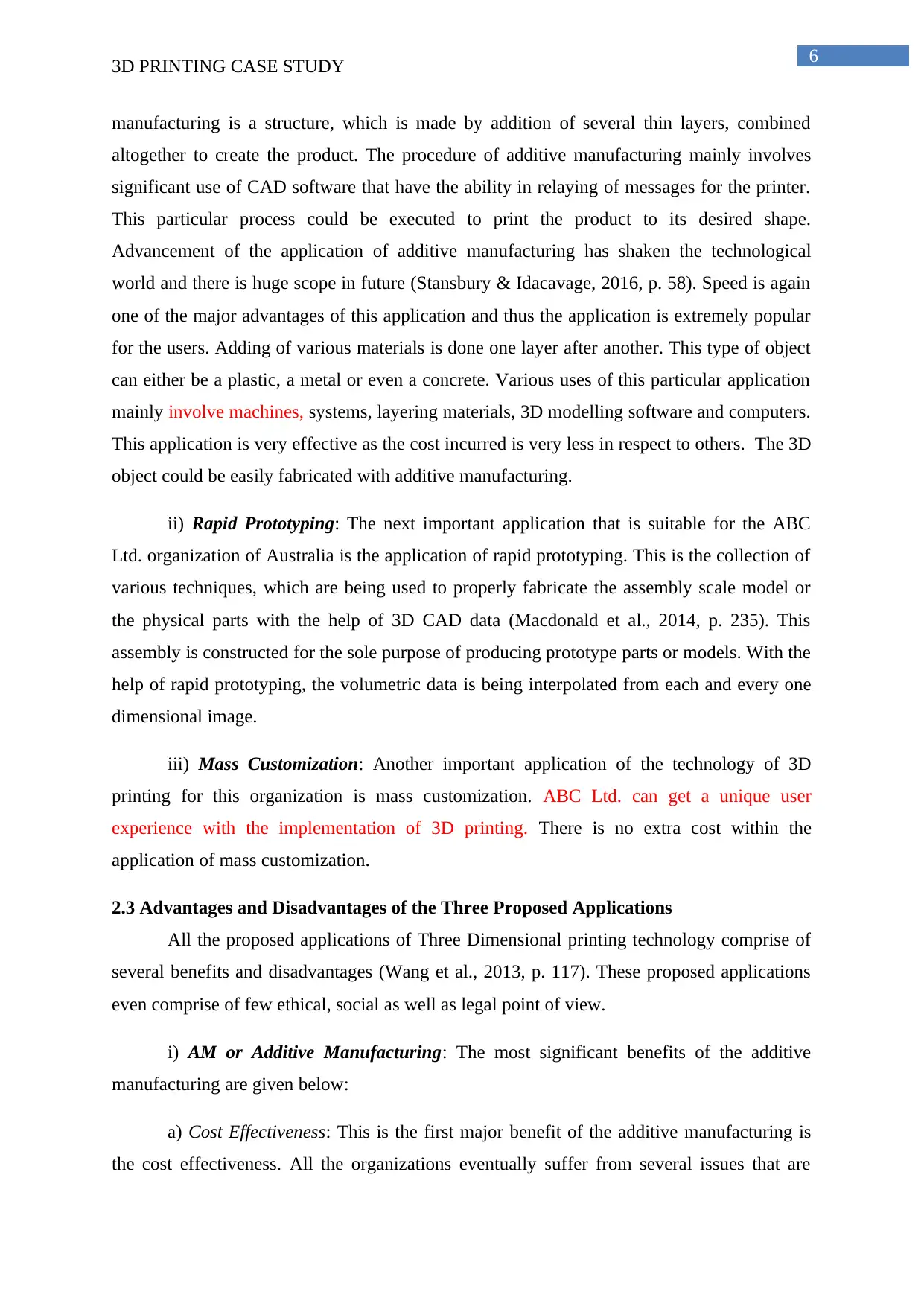
6
3D PRINTING CASE STUDY
manufacturing is a structure, which is made by addition of several thin layers, combined
altogether to create the product. The procedure of additive manufacturing mainly involves
significant use of CAD software that have the ability in relaying of messages for the printer.
This particular process could be executed to print the product to its desired shape.
Advancement of the application of additive manufacturing has shaken the technological
world and there is huge scope in future (Stansbury & Idacavage, 2016, p. 58). Speed is again
one of the major advantages of this application and thus the application is extremely popular
for the users. Adding of various materials is done one layer after another. This type of object
can either be a plastic, a metal or even a concrete. Various uses of this particular application
mainly involve machines, systems, layering materials, 3D modelling software and computers.
This application is very effective as the cost incurred is very less in respect to others. The 3D
object could be easily fabricated with additive manufacturing.
ii) Rapid Prototyping: The next important application that is suitable for the ABC
Ltd. organization of Australia is the application of rapid prototyping. This is the collection of
various techniques, which are being used to properly fabricate the assembly scale model or
the physical parts with the help of 3D CAD data (Macdonald et al., 2014, p. 235). This
assembly is constructed for the sole purpose of producing prototype parts or models. With the
help of rapid prototyping, the volumetric data is being interpolated from each and every one
dimensional image.
iii) Mass Customization: Another important application of the technology of 3D
printing for this organization is mass customization. ABC Ltd. can get a unique user
experience with the implementation of 3D printing. There is no extra cost within the
application of mass customization.
2.3 Advantages and Disadvantages of the Three Proposed Applications
All the proposed applications of Three Dimensional printing technology comprise of
several benefits and disadvantages (Wang et al., 2013, p. 117). These proposed applications
even comprise of few ethical, social as well as legal point of view.
i) AM or Additive Manufacturing: The most significant benefits of the additive
manufacturing are given below:
a) Cost Effectiveness: This is the first major benefit of the additive manufacturing is
the cost effectiveness. All the organizations eventually suffer from several issues that are
3D PRINTING CASE STUDY
manufacturing is a structure, which is made by addition of several thin layers, combined
altogether to create the product. The procedure of additive manufacturing mainly involves
significant use of CAD software that have the ability in relaying of messages for the printer.
This particular process could be executed to print the product to its desired shape.
Advancement of the application of additive manufacturing has shaken the technological
world and there is huge scope in future (Stansbury & Idacavage, 2016, p. 58). Speed is again
one of the major advantages of this application and thus the application is extremely popular
for the users. Adding of various materials is done one layer after another. This type of object
can either be a plastic, a metal or even a concrete. Various uses of this particular application
mainly involve machines, systems, layering materials, 3D modelling software and computers.
This application is very effective as the cost incurred is very less in respect to others. The 3D
object could be easily fabricated with additive manufacturing.
ii) Rapid Prototyping: The next important application that is suitable for the ABC
Ltd. organization of Australia is the application of rapid prototyping. This is the collection of
various techniques, which are being used to properly fabricate the assembly scale model or
the physical parts with the help of 3D CAD data (Macdonald et al., 2014, p. 235). This
assembly is constructed for the sole purpose of producing prototype parts or models. With the
help of rapid prototyping, the volumetric data is being interpolated from each and every one
dimensional image.
iii) Mass Customization: Another important application of the technology of 3D
printing for this organization is mass customization. ABC Ltd. can get a unique user
experience with the implementation of 3D printing. There is no extra cost within the
application of mass customization.
2.3 Advantages and Disadvantages of the Three Proposed Applications
All the proposed applications of Three Dimensional printing technology comprise of
several benefits and disadvantages (Wang et al., 2013, p. 117). These proposed applications
even comprise of few ethical, social as well as legal point of view.
i) AM or Additive Manufacturing: The most significant benefits of the additive
manufacturing are given below:
a) Cost Effectiveness: This is the first major benefit of the additive manufacturing is
the cost effectiveness. All the organizations eventually suffer from several issues that are
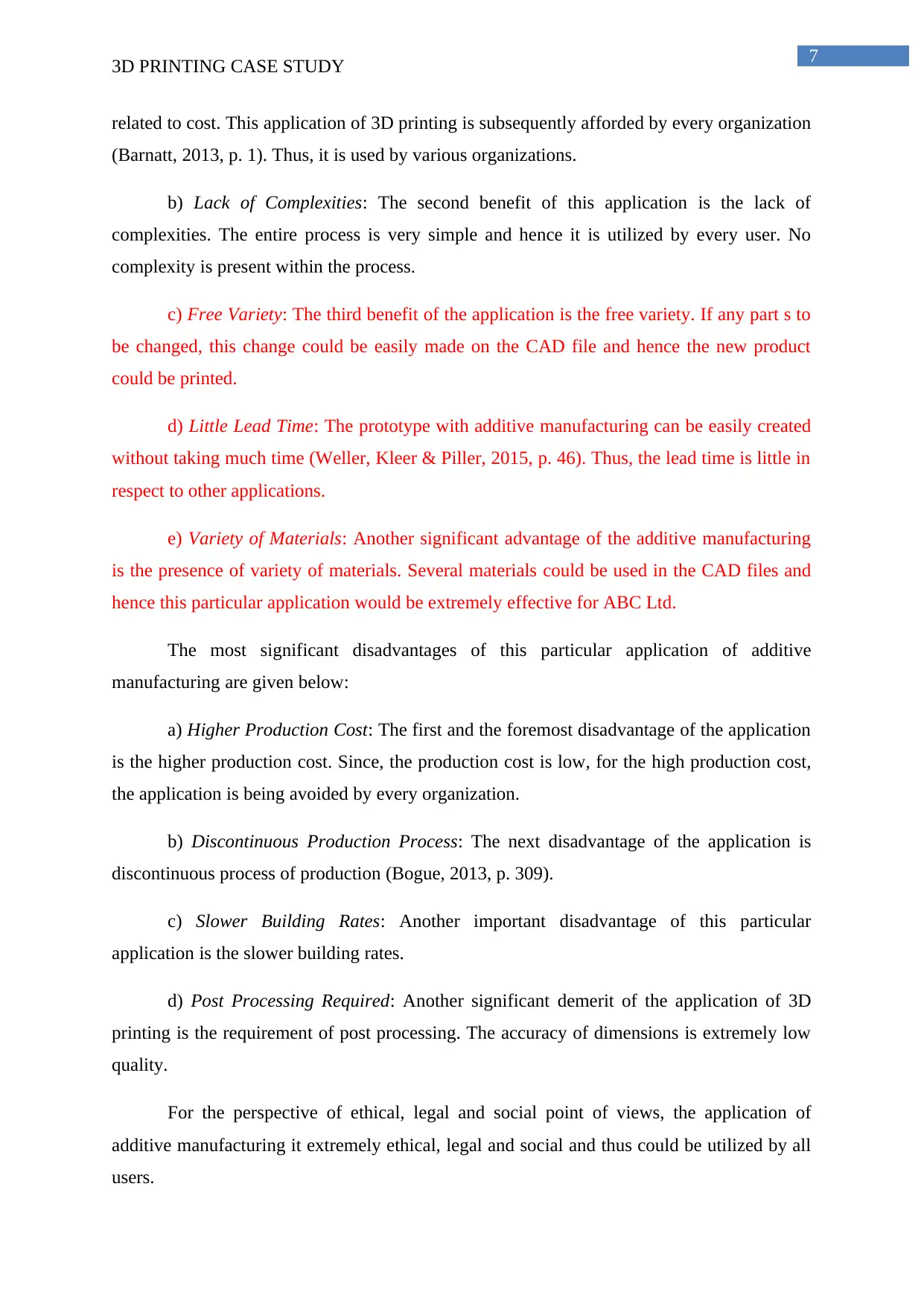
7
3D PRINTING CASE STUDY
related to cost. This application of 3D printing is subsequently afforded by every organization
(Barnatt, 2013, p. 1). Thus, it is used by various organizations.
b) Lack of Complexities: The second benefit of this application is the lack of
complexities. The entire process is very simple and hence it is utilized by every user. No
complexity is present within the process.
c) Free Variety: The third benefit of the application is the free variety. If any part s to
be changed, this change could be easily made on the CAD file and hence the new product
could be printed.
d) Little Lead Time: The prototype with additive manufacturing can be easily created
without taking much time (Weller, Kleer & Piller, 2015, p. 46). Thus, the lead time is little in
respect to other applications.
e) Variety of Materials: Another significant advantage of the additive manufacturing
is the presence of variety of materials. Several materials could be used in the CAD files and
hence this particular application would be extremely effective for ABC Ltd.
The most significant disadvantages of this particular application of additive
manufacturing are given below:
a) Higher Production Cost: The first and the foremost disadvantage of the application
is the higher production cost. Since, the production cost is low, for the high production cost,
the application is being avoided by every organization.
b) Discontinuous Production Process: The next disadvantage of the application is
discontinuous process of production (Bogue, 2013, p. 309).
c) Slower Building Rates: Another important disadvantage of this particular
application is the slower building rates.
d) Post Processing Required: Another significant demerit of the application of 3D
printing is the requirement of post processing. The accuracy of dimensions is extremely low
quality.
For the perspective of ethical, legal and social point of views, the application of
additive manufacturing it extremely ethical, legal and social and thus could be utilized by all
users.
3D PRINTING CASE STUDY
related to cost. This application of 3D printing is subsequently afforded by every organization
(Barnatt, 2013, p. 1). Thus, it is used by various organizations.
b) Lack of Complexities: The second benefit of this application is the lack of
complexities. The entire process is very simple and hence it is utilized by every user. No
complexity is present within the process.
c) Free Variety: The third benefit of the application is the free variety. If any part s to
be changed, this change could be easily made on the CAD file and hence the new product
could be printed.
d) Little Lead Time: The prototype with additive manufacturing can be easily created
without taking much time (Weller, Kleer & Piller, 2015, p. 46). Thus, the lead time is little in
respect to other applications.
e) Variety of Materials: Another significant advantage of the additive manufacturing
is the presence of variety of materials. Several materials could be used in the CAD files and
hence this particular application would be extremely effective for ABC Ltd.
The most significant disadvantages of this particular application of additive
manufacturing are given below:
a) Higher Production Cost: The first and the foremost disadvantage of the application
is the higher production cost. Since, the production cost is low, for the high production cost,
the application is being avoided by every organization.
b) Discontinuous Production Process: The next disadvantage of the application is
discontinuous process of production (Bogue, 2013, p. 309).
c) Slower Building Rates: Another important disadvantage of this particular
application is the slower building rates.
d) Post Processing Required: Another significant demerit of the application of 3D
printing is the requirement of post processing. The accuracy of dimensions is extremely low
quality.
For the perspective of ethical, legal and social point of views, the application of
additive manufacturing it extremely ethical, legal and social and thus could be utilized by all
users.
Paraphrase This Document
Need a fresh take? Get an instant paraphrase of this document with our AI Paraphraser
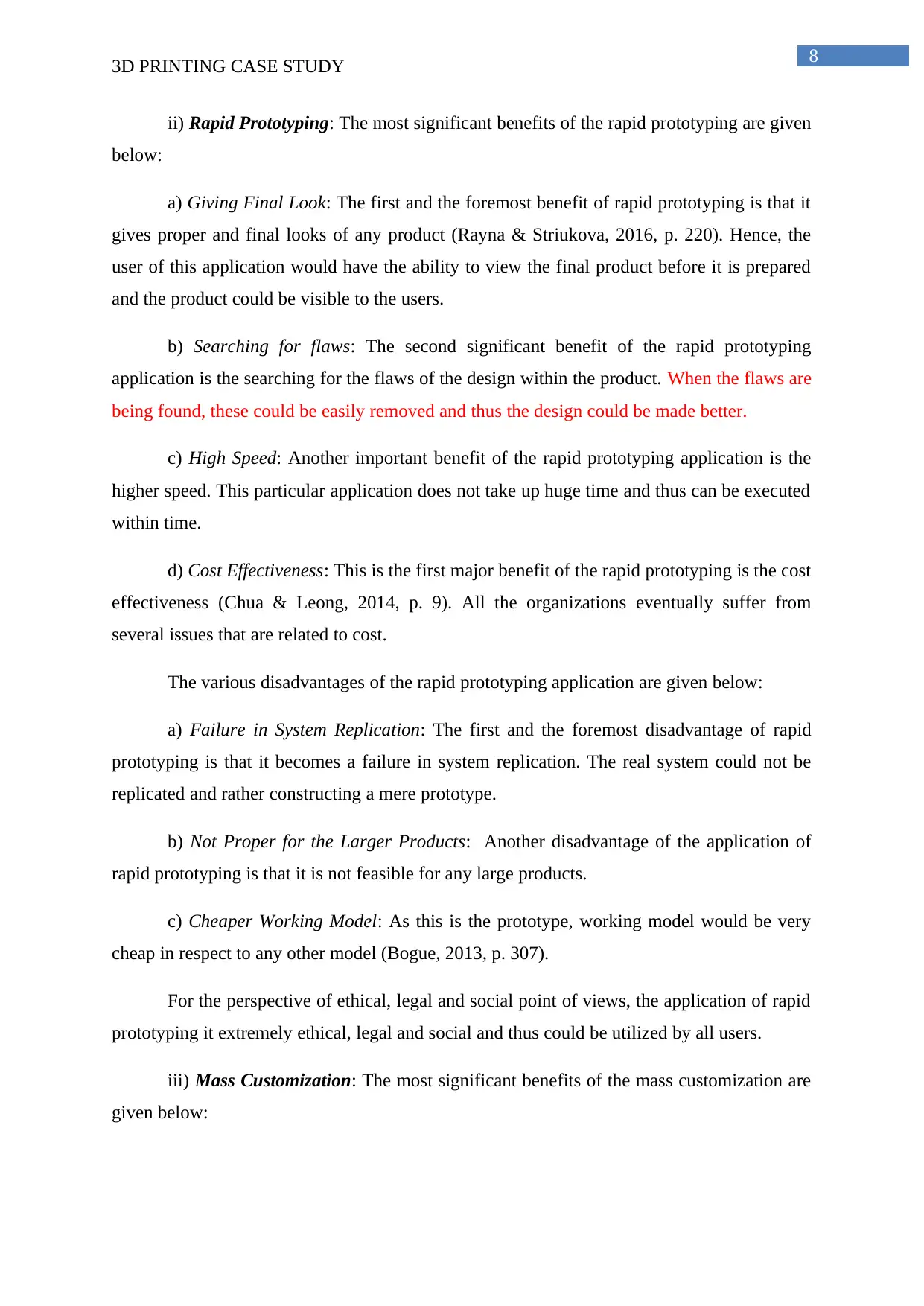
8
3D PRINTING CASE STUDY
ii) Rapid Prototyping: The most significant benefits of the rapid prototyping are given
below:
a) Giving Final Look: The first and the foremost benefit of rapid prototyping is that it
gives proper and final looks of any product (Rayna & Striukova, 2016, p. 220). Hence, the
user of this application would have the ability to view the final product before it is prepared
and the product could be visible to the users.
b) Searching for flaws: The second significant benefit of the rapid prototyping
application is the searching for the flaws of the design within the product. When the flaws are
being found, these could be easily removed and thus the design could be made better.
c) High Speed: Another important benefit of the rapid prototyping application is the
higher speed. This particular application does not take up huge time and thus can be executed
within time.
d) Cost Effectiveness: This is the first major benefit of the rapid prototyping is the cost
effectiveness (Chua & Leong, 2014, p. 9). All the organizations eventually suffer from
several issues that are related to cost.
The various disadvantages of the rapid prototyping application are given below:
a) Failure in System Replication: The first and the foremost disadvantage of rapid
prototyping is that it becomes a failure in system replication. The real system could not be
replicated and rather constructing a mere prototype.
b) Not Proper for the Larger Products: Another disadvantage of the application of
rapid prototyping is that it is not feasible for any large products.
c) Cheaper Working Model: As this is the prototype, working model would be very
cheap in respect to any other model (Bogue, 2013, p. 307).
For the perspective of ethical, legal and social point of views, the application of rapid
prototyping it extremely ethical, legal and social and thus could be utilized by all users.
iii) Mass Customization: The most significant benefits of the mass customization are
given below:
3D PRINTING CASE STUDY
ii) Rapid Prototyping: The most significant benefits of the rapid prototyping are given
below:
a) Giving Final Look: The first and the foremost benefit of rapid prototyping is that it
gives proper and final looks of any product (Rayna & Striukova, 2016, p. 220). Hence, the
user of this application would have the ability to view the final product before it is prepared
and the product could be visible to the users.
b) Searching for flaws: The second significant benefit of the rapid prototyping
application is the searching for the flaws of the design within the product. When the flaws are
being found, these could be easily removed and thus the design could be made better.
c) High Speed: Another important benefit of the rapid prototyping application is the
higher speed. This particular application does not take up huge time and thus can be executed
within time.
d) Cost Effectiveness: This is the first major benefit of the rapid prototyping is the cost
effectiveness (Chua & Leong, 2014, p. 9). All the organizations eventually suffer from
several issues that are related to cost.
The various disadvantages of the rapid prototyping application are given below:
a) Failure in System Replication: The first and the foremost disadvantage of rapid
prototyping is that it becomes a failure in system replication. The real system could not be
replicated and rather constructing a mere prototype.
b) Not Proper for the Larger Products: Another disadvantage of the application of
rapid prototyping is that it is not feasible for any large products.
c) Cheaper Working Model: As this is the prototype, working model would be very
cheap in respect to any other model (Bogue, 2013, p. 307).
For the perspective of ethical, legal and social point of views, the application of rapid
prototyping it extremely ethical, legal and social and thus could be utilized by all users.
iii) Mass Customization: The most significant benefits of the mass customization are
given below:
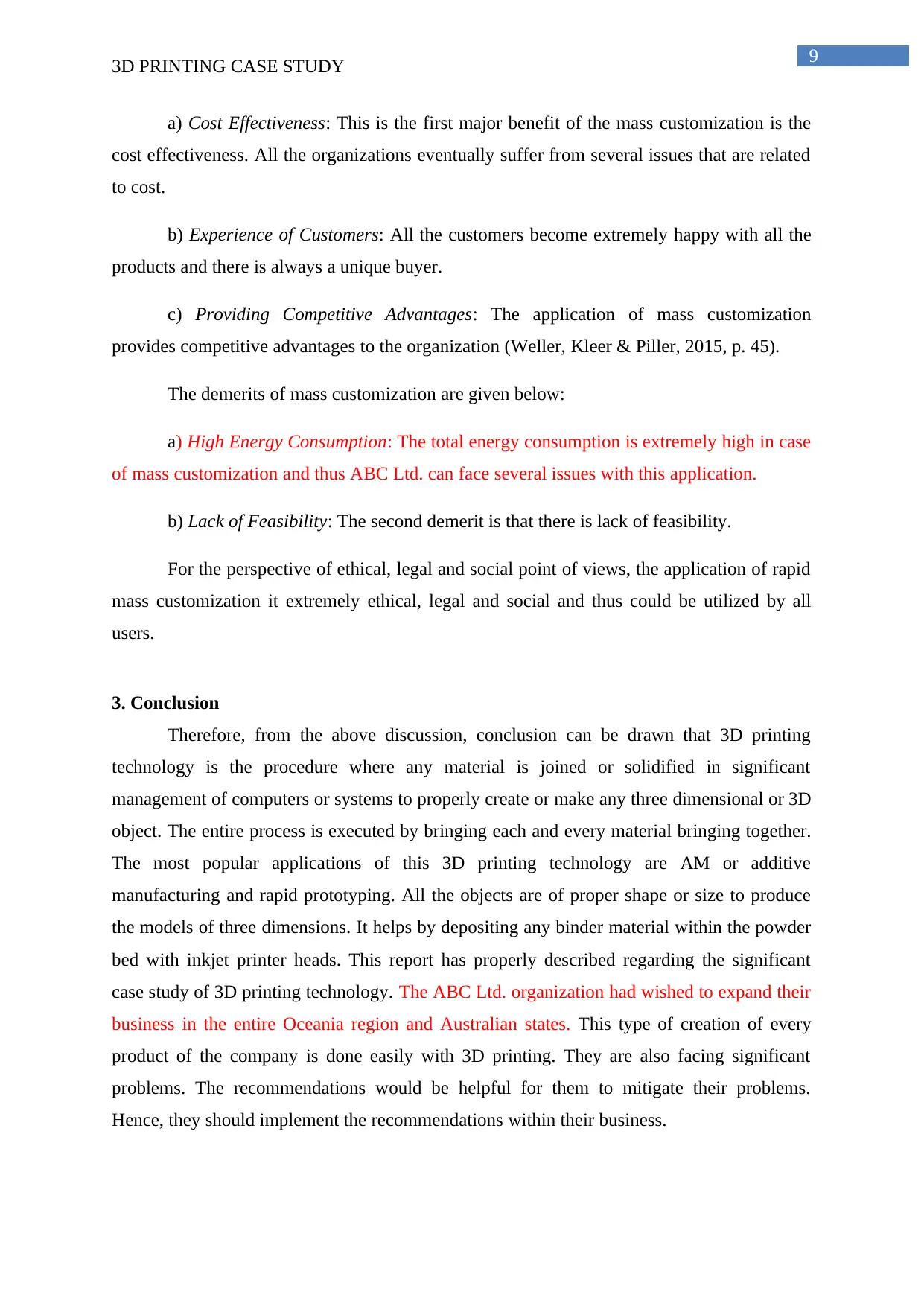
9
3D PRINTING CASE STUDY
a) Cost Effectiveness: This is the first major benefit of the mass customization is the
cost effectiveness. All the organizations eventually suffer from several issues that are related
to cost.
b) Experience of Customers: All the customers become extremely happy with all the
products and there is always a unique buyer.
c) Providing Competitive Advantages: The application of mass customization
provides competitive advantages to the organization (Weller, Kleer & Piller, 2015, p. 45).
The demerits of mass customization are given below:
a) High Energy Consumption: The total energy consumption is extremely high in case
of mass customization and thus ABC Ltd. can face several issues with this application.
b) Lack of Feasibility: The second demerit is that there is lack of feasibility.
For the perspective of ethical, legal and social point of views, the application of rapid
mass customization it extremely ethical, legal and social and thus could be utilized by all
users.
3. Conclusion
Therefore, from the above discussion, conclusion can be drawn that 3D printing
technology is the procedure where any material is joined or solidified in significant
management of computers or systems to properly create or make any three dimensional or 3D
object. The entire process is executed by bringing each and every material bringing together.
The most popular applications of this 3D printing technology are AM or additive
manufacturing and rapid prototyping. All the objects are of proper shape or size to produce
the models of three dimensions. It helps by depositing any binder material within the powder
bed with inkjet printer heads. This report has properly described regarding the significant
case study of 3D printing technology. The ABC Ltd. organization had wished to expand their
business in the entire Oceania region and Australian states. This type of creation of every
product of the company is done easily with 3D printing. They are also facing significant
problems. The recommendations would be helpful for them to mitigate their problems.
Hence, they should implement the recommendations within their business.
3D PRINTING CASE STUDY
a) Cost Effectiveness: This is the first major benefit of the mass customization is the
cost effectiveness. All the organizations eventually suffer from several issues that are related
to cost.
b) Experience of Customers: All the customers become extremely happy with all the
products and there is always a unique buyer.
c) Providing Competitive Advantages: The application of mass customization
provides competitive advantages to the organization (Weller, Kleer & Piller, 2015, p. 45).
The demerits of mass customization are given below:
a) High Energy Consumption: The total energy consumption is extremely high in case
of mass customization and thus ABC Ltd. can face several issues with this application.
b) Lack of Feasibility: The second demerit is that there is lack of feasibility.
For the perspective of ethical, legal and social point of views, the application of rapid
mass customization it extremely ethical, legal and social and thus could be utilized by all
users.
3. Conclusion
Therefore, from the above discussion, conclusion can be drawn that 3D printing
technology is the procedure where any material is joined or solidified in significant
management of computers or systems to properly create or make any three dimensional or 3D
object. The entire process is executed by bringing each and every material bringing together.
The most popular applications of this 3D printing technology are AM or additive
manufacturing and rapid prototyping. All the objects are of proper shape or size to produce
the models of three dimensions. It helps by depositing any binder material within the powder
bed with inkjet printer heads. This report has properly described regarding the significant
case study of 3D printing technology. The ABC Ltd. organization had wished to expand their
business in the entire Oceania region and Australian states. This type of creation of every
product of the company is done easily with 3D printing. They are also facing significant
problems. The recommendations would be helpful for them to mitigate their problems.
Hence, they should implement the recommendations within their business.
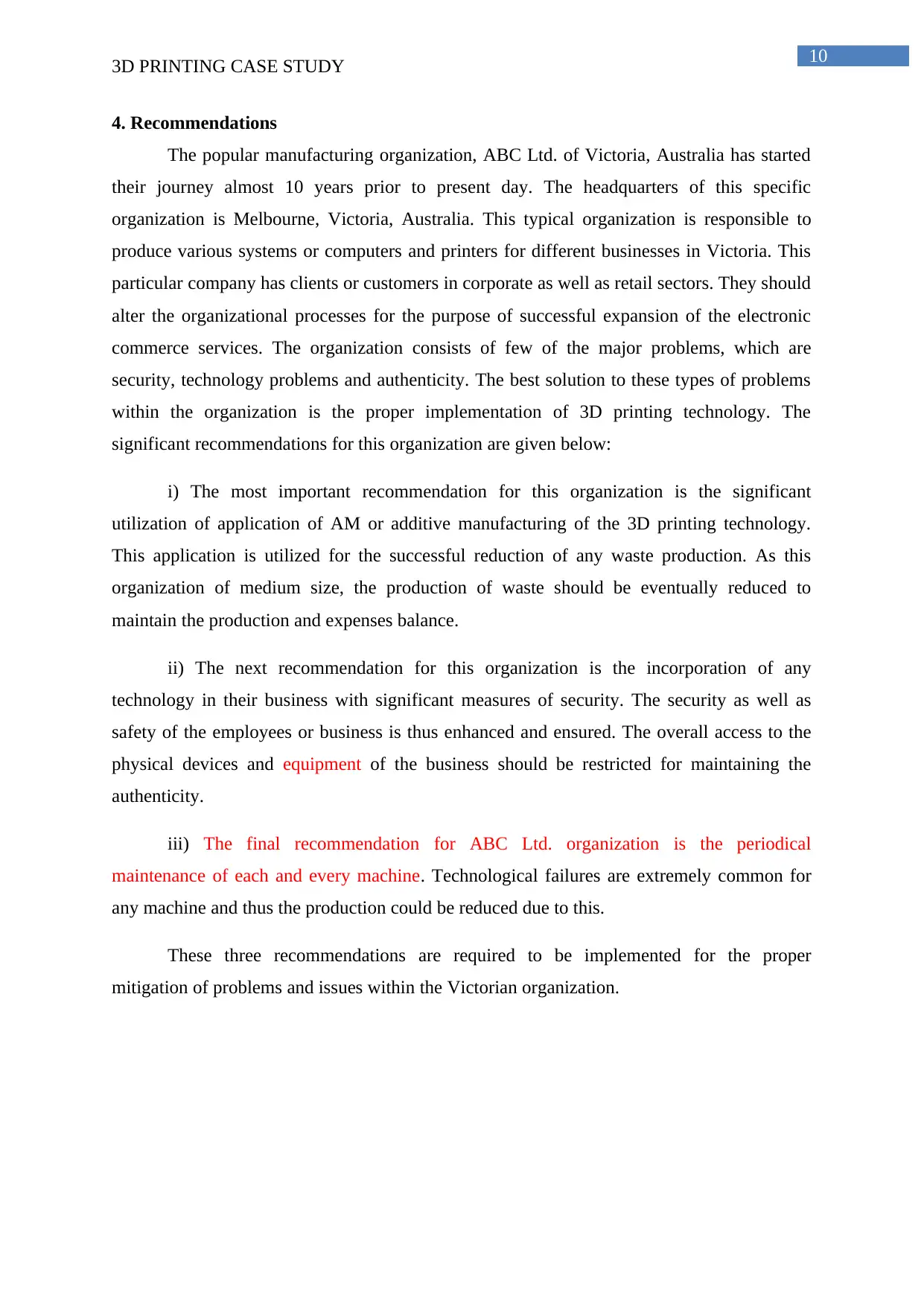
10
3D PRINTING CASE STUDY
4. Recommendations
The popular manufacturing organization, ABC Ltd. of Victoria, Australia has started
their journey almost 10 years prior to present day. The headquarters of this specific
organization is Melbourne, Victoria, Australia. This typical organization is responsible to
produce various systems or computers and printers for different businesses in Victoria. This
particular company has clients or customers in corporate as well as retail sectors. They should
alter the organizational processes for the purpose of successful expansion of the electronic
commerce services. The organization consists of few of the major problems, which are
security, technology problems and authenticity. The best solution to these types of problems
within the organization is the proper implementation of 3D printing technology. The
significant recommendations for this organization are given below:
i) The most important recommendation for this organization is the significant
utilization of application of AM or additive manufacturing of the 3D printing technology.
This application is utilized for the successful reduction of any waste production. As this
organization of medium size, the production of waste should be eventually reduced to
maintain the production and expenses balance.
ii) The next recommendation for this organization is the incorporation of any
technology in their business with significant measures of security. The security as well as
safety of the employees or business is thus enhanced and ensured. The overall access to the
physical devices and equipment of the business should be restricted for maintaining the
authenticity.
iii) The final recommendation for ABC Ltd. organization is the periodical
maintenance of each and every machine. Technological failures are extremely common for
any machine and thus the production could be reduced due to this.
These three recommendations are required to be implemented for the proper
mitigation of problems and issues within the Victorian organization.
3D PRINTING CASE STUDY
4. Recommendations
The popular manufacturing organization, ABC Ltd. of Victoria, Australia has started
their journey almost 10 years prior to present day. The headquarters of this specific
organization is Melbourne, Victoria, Australia. This typical organization is responsible to
produce various systems or computers and printers for different businesses in Victoria. This
particular company has clients or customers in corporate as well as retail sectors. They should
alter the organizational processes for the purpose of successful expansion of the electronic
commerce services. The organization consists of few of the major problems, which are
security, technology problems and authenticity. The best solution to these types of problems
within the organization is the proper implementation of 3D printing technology. The
significant recommendations for this organization are given below:
i) The most important recommendation for this organization is the significant
utilization of application of AM or additive manufacturing of the 3D printing technology.
This application is utilized for the successful reduction of any waste production. As this
organization of medium size, the production of waste should be eventually reduced to
maintain the production and expenses balance.
ii) The next recommendation for this organization is the incorporation of any
technology in their business with significant measures of security. The security as well as
safety of the employees or business is thus enhanced and ensured. The overall access to the
physical devices and equipment of the business should be restricted for maintaining the
authenticity.
iii) The final recommendation for ABC Ltd. organization is the periodical
maintenance of each and every machine. Technological failures are extremely common for
any machine and thus the production could be reduced due to this.
These three recommendations are required to be implemented for the proper
mitigation of problems and issues within the Victorian organization.
Secure Best Marks with AI Grader
Need help grading? Try our AI Grader for instant feedback on your assignments.
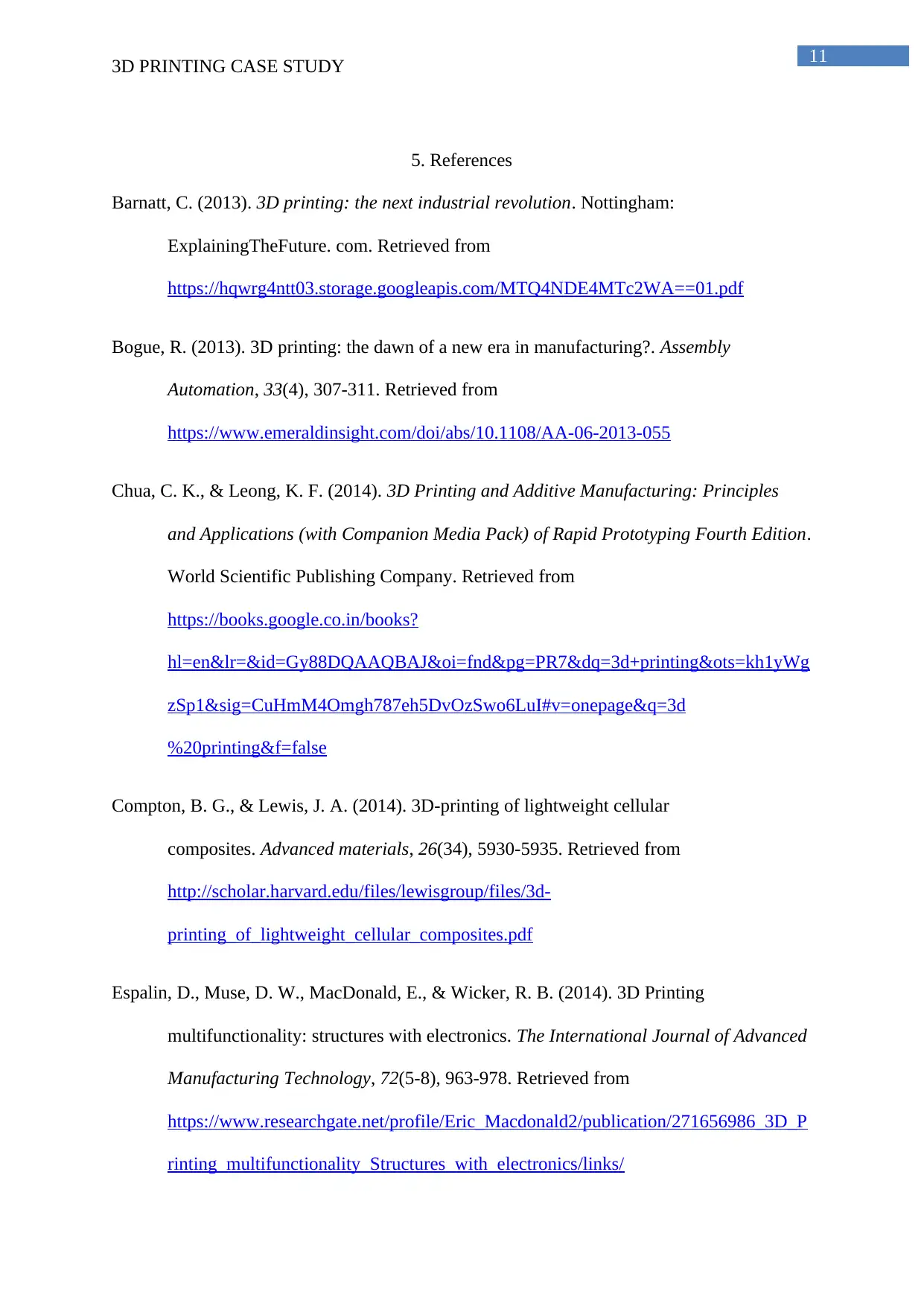
11
3D PRINTING CASE STUDY
5. References
Barnatt, C. (2013). 3D printing: the next industrial revolution. Nottingham:
ExplainingTheFuture. com. Retrieved from
https://hqwrg4ntt03.storage.googleapis.com/MTQ4NDE4MTc2WA==01.pdf
Bogue, R. (2013). 3D printing: the dawn of a new era in manufacturing?. Assembly
Automation, 33(4), 307-311. Retrieved from
https://www.emeraldinsight.com/doi/abs/10.1108/AA-06-2013-055
Chua, C. K., & Leong, K. F. (2014). 3D Printing and Additive Manufacturing: Principles
and Applications (with Companion Media Pack) of Rapid Prototyping Fourth Edition.
World Scientific Publishing Company. Retrieved from
https://books.google.co.in/books?
hl=en&lr=&id=Gy88DQAAQBAJ&oi=fnd&pg=PR7&dq=3d+printing&ots=kh1yWg
zSp1&sig=CuHmM4Omgh787eh5DvOzSwo6LuI#v=onepage&q=3d
%20printing&f=false
Compton, B. G., & Lewis, J. A. (2014). 3D‐printing of lightweight cellular
composites. Advanced materials, 26(34), 5930-5935. Retrieved from
http://scholar.harvard.edu/files/lewisgroup/files/3d-
printing_of_lightweight_cellular_composites.pdf
Espalin, D., Muse, D. W., MacDonald, E., & Wicker, R. B. (2014). 3D Printing
multifunctionality: structures with electronics. The International Journal of Advanced
Manufacturing Technology, 72(5-8), 963-978. Retrieved from
https://www.researchgate.net/profile/Eric_Macdonald2/publication/271656986_3D_P
rinting_multifunctionality_Structures_with_electronics/links/
3D PRINTING CASE STUDY
5. References
Barnatt, C. (2013). 3D printing: the next industrial revolution. Nottingham:
ExplainingTheFuture. com. Retrieved from
https://hqwrg4ntt03.storage.googleapis.com/MTQ4NDE4MTc2WA==01.pdf
Bogue, R. (2013). 3D printing: the dawn of a new era in manufacturing?. Assembly
Automation, 33(4), 307-311. Retrieved from
https://www.emeraldinsight.com/doi/abs/10.1108/AA-06-2013-055
Chua, C. K., & Leong, K. F. (2014). 3D Printing and Additive Manufacturing: Principles
and Applications (with Companion Media Pack) of Rapid Prototyping Fourth Edition.
World Scientific Publishing Company. Retrieved from
https://books.google.co.in/books?
hl=en&lr=&id=Gy88DQAAQBAJ&oi=fnd&pg=PR7&dq=3d+printing&ots=kh1yWg
zSp1&sig=CuHmM4Omgh787eh5DvOzSwo6LuI#v=onepage&q=3d
%20printing&f=false
Compton, B. G., & Lewis, J. A. (2014). 3D‐printing of lightweight cellular
composites. Advanced materials, 26(34), 5930-5935. Retrieved from
http://scholar.harvard.edu/files/lewisgroup/files/3d-
printing_of_lightweight_cellular_composites.pdf
Espalin, D., Muse, D. W., MacDonald, E., & Wicker, R. B. (2014). 3D Printing
multifunctionality: structures with electronics. The International Journal of Advanced
Manufacturing Technology, 72(5-8), 963-978. Retrieved from
https://www.researchgate.net/profile/Eric_Macdonald2/publication/271656986_3D_P
rinting_multifunctionality_Structures_with_electronics/links/
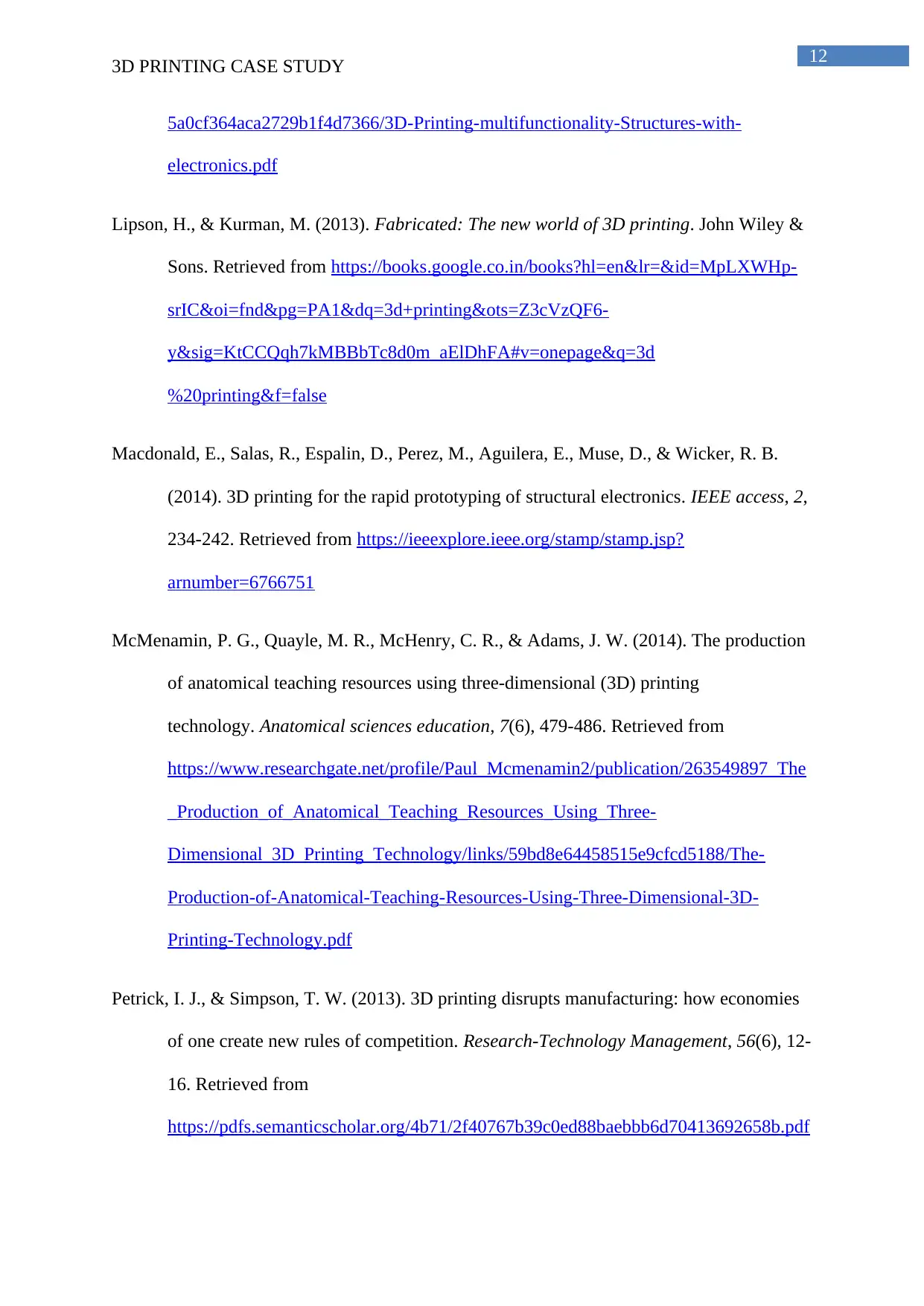
12
3D PRINTING CASE STUDY
5a0cf364aca2729b1f4d7366/3D-Printing-multifunctionality-Structures-with-
electronics.pdf
Lipson, H., & Kurman, M. (2013). Fabricated: The new world of 3D printing. John Wiley &
Sons. Retrieved from https://books.google.co.in/books?hl=en&lr=&id=MpLXWHp-
srIC&oi=fnd&pg=PA1&dq=3d+printing&ots=Z3cVzQF6-
y&sig=KtCCQqh7kMBBbTc8d0m_aElDhFA#v=onepage&q=3d
%20printing&f=false
Macdonald, E., Salas, R., Espalin, D., Perez, M., Aguilera, E., Muse, D., & Wicker, R. B.
(2014). 3D printing for the rapid prototyping of structural electronics. IEEE access, 2,
234-242. Retrieved from https://ieeexplore.ieee.org/stamp/stamp.jsp?
arnumber=6766751
McMenamin, P. G., Quayle, M. R., McHenry, C. R., & Adams, J. W. (2014). The production
of anatomical teaching resources using three‐dimensional (3D) printing
technology. Anatomical sciences education, 7(6), 479-486. Retrieved from
https://www.researchgate.net/profile/Paul_Mcmenamin2/publication/263549897_The
_Production_of_Anatomical_Teaching_Resources_Using_Three-
Dimensional_3D_Printing_Technology/links/59bd8e64458515e9cfcd5188/The-
Production-of-Anatomical-Teaching-Resources-Using-Three-Dimensional-3D-
Printing-Technology.pdf
Petrick, I. J., & Simpson, T. W. (2013). 3D printing disrupts manufacturing: how economies
of one create new rules of competition. Research-Technology Management, 56(6), 12-
16. Retrieved from
https://pdfs.semanticscholar.org/4b71/2f40767b39c0ed88baebbb6d70413692658b.pdf
3D PRINTING CASE STUDY
5a0cf364aca2729b1f4d7366/3D-Printing-multifunctionality-Structures-with-
electronics.pdf
Lipson, H., & Kurman, M. (2013). Fabricated: The new world of 3D printing. John Wiley &
Sons. Retrieved from https://books.google.co.in/books?hl=en&lr=&id=MpLXWHp-
srIC&oi=fnd&pg=PA1&dq=3d+printing&ots=Z3cVzQF6-
y&sig=KtCCQqh7kMBBbTc8d0m_aElDhFA#v=onepage&q=3d
%20printing&f=false
Macdonald, E., Salas, R., Espalin, D., Perez, M., Aguilera, E., Muse, D., & Wicker, R. B.
(2014). 3D printing for the rapid prototyping of structural electronics. IEEE access, 2,
234-242. Retrieved from https://ieeexplore.ieee.org/stamp/stamp.jsp?
arnumber=6766751
McMenamin, P. G., Quayle, M. R., McHenry, C. R., & Adams, J. W. (2014). The production
of anatomical teaching resources using three‐dimensional (3D) printing
technology. Anatomical sciences education, 7(6), 479-486. Retrieved from
https://www.researchgate.net/profile/Paul_Mcmenamin2/publication/263549897_The
_Production_of_Anatomical_Teaching_Resources_Using_Three-
Dimensional_3D_Printing_Technology/links/59bd8e64458515e9cfcd5188/The-
Production-of-Anatomical-Teaching-Resources-Using-Three-Dimensional-3D-
Printing-Technology.pdf
Petrick, I. J., & Simpson, T. W. (2013). 3D printing disrupts manufacturing: how economies
of one create new rules of competition. Research-Technology Management, 56(6), 12-
16. Retrieved from
https://pdfs.semanticscholar.org/4b71/2f40767b39c0ed88baebbb6d70413692658b.pdf
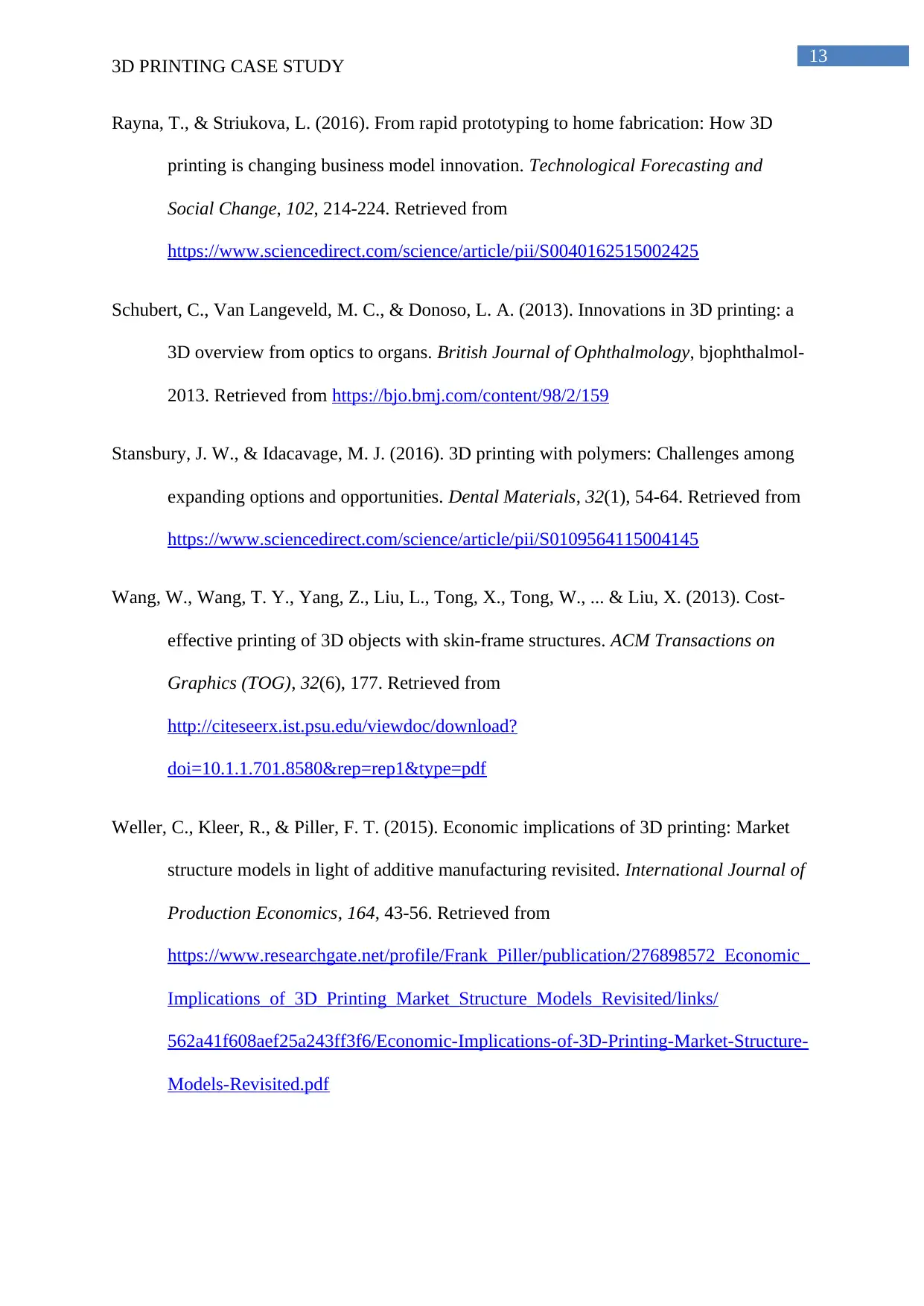
13
3D PRINTING CASE STUDY
Rayna, T., & Striukova, L. (2016). From rapid prototyping to home fabrication: How 3D
printing is changing business model innovation. Technological Forecasting and
Social Change, 102, 214-224. Retrieved from
https://www.sciencedirect.com/science/article/pii/S0040162515002425
Schubert, C., Van Langeveld, M. C., & Donoso, L. A. (2013). Innovations in 3D printing: a
3D overview from optics to organs. British Journal of Ophthalmology, bjophthalmol-
2013. Retrieved from https://bjo.bmj.com/content/98/2/159
Stansbury, J. W., & Idacavage, M. J. (2016). 3D printing with polymers: Challenges among
expanding options and opportunities. Dental Materials, 32(1), 54-64. Retrieved from
https://www.sciencedirect.com/science/article/pii/S0109564115004145
Wang, W., Wang, T. Y., Yang, Z., Liu, L., Tong, X., Tong, W., ... & Liu, X. (2013). Cost-
effective printing of 3D objects with skin-frame structures. ACM Transactions on
Graphics (TOG), 32(6), 177. Retrieved from
http://citeseerx.ist.psu.edu/viewdoc/download?
doi=10.1.1.701.8580&rep=rep1&type=pdf
Weller, C., Kleer, R., & Piller, F. T. (2015). Economic implications of 3D printing: Market
structure models in light of additive manufacturing revisited. International Journal of
Production Economics, 164, 43-56. Retrieved from
https://www.researchgate.net/profile/Frank_Piller/publication/276898572_Economic_
Implications_of_3D_Printing_Market_Structure_Models_Revisited/links/
562a41f608aef25a243ff3f6/Economic-Implications-of-3D-Printing-Market-Structure-
Models-Revisited.pdf
3D PRINTING CASE STUDY
Rayna, T., & Striukova, L. (2016). From rapid prototyping to home fabrication: How 3D
printing is changing business model innovation. Technological Forecasting and
Social Change, 102, 214-224. Retrieved from
https://www.sciencedirect.com/science/article/pii/S0040162515002425
Schubert, C., Van Langeveld, M. C., & Donoso, L. A. (2013). Innovations in 3D printing: a
3D overview from optics to organs. British Journal of Ophthalmology, bjophthalmol-
2013. Retrieved from https://bjo.bmj.com/content/98/2/159
Stansbury, J. W., & Idacavage, M. J. (2016). 3D printing with polymers: Challenges among
expanding options and opportunities. Dental Materials, 32(1), 54-64. Retrieved from
https://www.sciencedirect.com/science/article/pii/S0109564115004145
Wang, W., Wang, T. Y., Yang, Z., Liu, L., Tong, X., Tong, W., ... & Liu, X. (2013). Cost-
effective printing of 3D objects with skin-frame structures. ACM Transactions on
Graphics (TOG), 32(6), 177. Retrieved from
http://citeseerx.ist.psu.edu/viewdoc/download?
doi=10.1.1.701.8580&rep=rep1&type=pdf
Weller, C., Kleer, R., & Piller, F. T. (2015). Economic implications of 3D printing: Market
structure models in light of additive manufacturing revisited. International Journal of
Production Economics, 164, 43-56. Retrieved from
https://www.researchgate.net/profile/Frank_Piller/publication/276898572_Economic_
Implications_of_3D_Printing_Market_Structure_Models_Revisited/links/
562a41f608aef25a243ff3f6/Economic-Implications-of-3D-Printing-Market-Structure-
Models-Revisited.pdf
Paraphrase This Document
Need a fresh take? Get an instant paraphrase of this document with our AI Paraphraser

14
3D PRINTING CASE STUDY
3D PRINTING CASE STUDY
1 out of 14
Related Documents
Your All-in-One AI-Powered Toolkit for Academic Success.
+13062052269
info@desklib.com
Available 24*7 on WhatsApp / Email
![[object Object]](/_next/static/media/star-bottom.7253800d.svg)
Unlock your academic potential
© 2024 | Zucol Services PVT LTD | All rights reserved.





